KIA Niro: Refrigerant System Service Basics (R- 1234yf)
Refrigerant Identification
- Do not mix HFO-1234yf (R-1234yf) in the vehicle with other refrigerant, such as R-12, R-134a and etc.
- Use only the UL-listed service equipment certified to meet the requirements of SAE standards to recover and recycle R-1234yf from the air conditioning system. Do not use service equipment for the other refrigerant, such as R-12, R-134a and etc.
- Verify what refrigerant is in the system if there is concern that the system has been tampered in any way and check the type and quantity of refrigerant in the A/C system and potential issues arising from accidental or intentional mixing of refrigerants.
- Using an SAE certified refrigerant identification device is recommended
to prevent improper recovery and the resulting further spread of
contaminated refrigerant, which could
potentially damage other A/C systems and service equipment. Contaminated
refrigerant (blend of more than one refrigerant or non-system refrigerant)
in recovery/recycling
equipment could lead to the potential contamination of more refrigerant. - Certain types of electronic leak detection devices (heated diode or corona discharge) as well as motors, switches, and controls on recovery and recycling machines, could generate sparks that could serve as ignition sources in the presence of refrigerants classified as flammables (A2 or A3) by ASHRAE standard 34 2006.
- It is possible that the mixing of refrigerants in an A/C system can result in higher-than-expected system pressures, system and component damage, diagnostic errors and/or other potential hazards to people and environment.
- In case other refrigerant is mixed, recover the contaminated refrigerant
in the A/C system and dispose it in accordance with all applicable national,
regional or local regulations.
Clean inside the A/C system using the specialized detergent and recharge new refrigerant.
Refrigerant Recovery
Use only the UL-listed service equipment certified to meet the requirements of SAE standards to remove HFO-1234yf (R-1234yf) from the air conditioning system.
Warning
- Air conditioning refrigerant or lubricant vapor can irritate your eyes, nose, or throat.
- Be careful when connecting service equipment.
- Do not breathe in refrigerant or vapor.
If accidental system discharge occurs, ventilate work area before resume of service.
Additional health and safety information may be obtained from the refrigerant and lubricant manufacturers.
- Connect an R-1234yf refrigerant Recovery/Recycling/Charging System (A) to the high-pressure service port (B) and the low-pressure service port (C) as shown, following the equipment manufacturer's instructions.
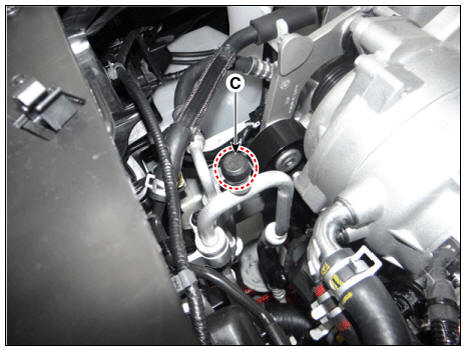
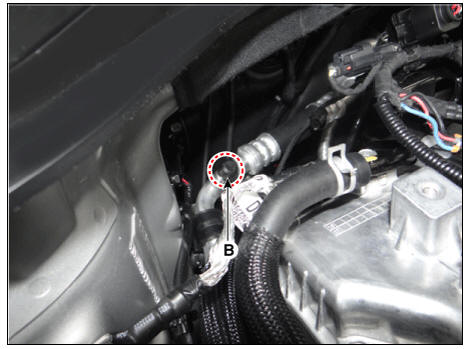
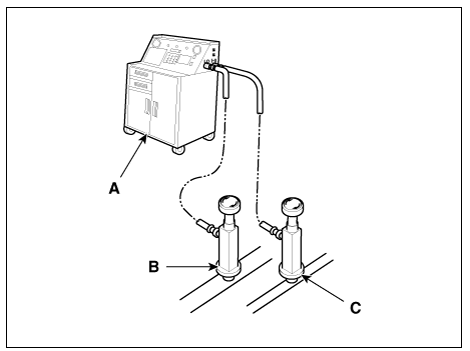
- Measure the amount of refrigerant oil removed from the A/C system after the recovery process is completed. Be sure to install the same amount of new refrigerant oil back into the A/C system before charging.
System Evacuation
Use only the UL-listed service equipment certified to meet the requirements of SAE standards to remove HFO-1234yf (R-1234yf) from the air conditioning system.
Warning
- Air conditioning refrigerant or lubricant vapor can irritate your eyes, nose, or throat.
- Be careful when connecting service equipment.
- Do not breathe in refrigerant or vapor.
If accidental system discharge occurs, ventilate work area before resume of service.
Additional health and safety information may be obtained from the refrigerant and lubricant manufacturers.
- When an A/C System has been open to the atmosphere, during installation
or service, it must be evacuated using an R-1234yf refrigerant Recovery/Recycling/Charging
System. (If
the system has been open for several days, the receiver/dryer should be replaced, and the system should be evacuated for several hours.) - Connect an R-1234yf refrigerant Recovery/Recycling/Charging System (A) to the high-pressure service port (B) and the low-pressure service port (C) as shown, following the equipment manufacturer's instructions.
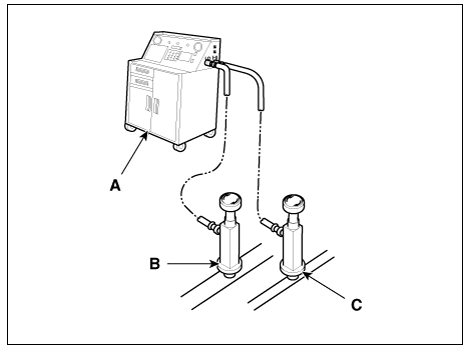
- If the low-pressure does not reach more than 87.7 kPa (658 mmHg, 25.9
in.Hg) in 5 minutes, there is probably a leak in the system. Partially
charge the system, and check for leaks
(see "Refrigerant Leak Test").
4. Remove the low pressure valve from the low-pressure service port.
System Charging
Use only the UL-listed service equipment certified to meet the requirements of SAE standards to remove HFO-1234yf (R-1234yf) from the air conditioning system.
Warning
- Air conditioning refrigerant or lubricant vapor can irritate your eyes, nose, or throat.
- Be careful when connecting service equipment.
- Do not breathe in refrigerant or vapor.
If accidental system discharge occurs, ventilate work area before resume of service.
Additional health and safety information may be obtained from the refrigerant and lubricant manufacturers.
- Connect an R-1234yf refrigerant Recovery/Recycling/Charging System (A) to the high-pressure service port (B) and the low-pressure service port (C) as shown, following the equipment manufacturer's instructions.
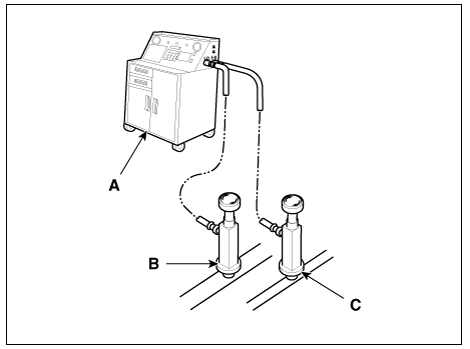
- Add the same amount of new refrigerant oil to the system that was removed during recovery. Use only specified refrigerant oil. Charge the system with R-134a or R-1234yf refrigerant. Do not overcharge the system as it may damage the compressor.
Specified amount 550 +- 25g (19.4 +- 0.8 oz.)
Refrigerant Leak Test
Always conduct a leak test with an electronic leak detector whenever leakage
or refrigerant is suspected and when conducting service operations accompanied
by disassembly or
loosening or connection fittings.
Warning
For proper use of the leak detector, follow the manufacturer instructions.
Warning
Use only leak detection devices certified to SAE standards for use
with R-1234yf. Certain leak detection devices (heated diode or corona discharge)
could serve as ignition
sources in the presence of hydrocarbons or other flammable refrigerants.
If a gas leak is detected, proceed as follows :
- Check the torque on the connection fittings. If it is too loose, tighten to the proper torque. Check for gas leakage with a leak detector (A).
- If leakage continues even after the fitting has been tightened, discharge the refrigerant from the system, disconnect the fittings, and check their seating faces for damage. Always replace, even if the damage is slight.
- Check the compressor oil and add oil if required.
- Charge the system and recheck for gas leaks. If no leaks are found,
evacuate and charge the system again.

Compressor
RPM check
- Push the A/C control switch ON.
- Check the engine RPM.
Warning
When the compressor operates, RPM increases.
- When the compressor is operating, RPM should be as follows.

Sound check
- Push the A/C control switch ON.
- Check the compressor from the engine room.
- When the compressor is operating, a clacking sound is heard.
Warning
If the compressor isn't operating, there is no sound.
READ NEXT:
 Filter inspection
Filter inspection
The climate control air filter should be replaced according to the
maintenance schedule.
If the vehicle is operated in severely air-polluted cities or on dusty rough
roads for a long period, it
should be inspected more frequently and replaced
 Normal Maintenance Schedule - For Gasoline Engine
Normal Maintenance Schedule - For Gasoline Engine
The following maintenance services must be performed to ensure good emission
control and
performance. Keep receipts for all vehicle emission services to protect your
warranty.Where both
mileage and time are shown, the frequency of service is de
SEE MORE:
 Overhead Console Lamp Repair procedures | Hazard Lamp Switch
Overhead Console Lamp Repair procedures | Hazard Lamp Switch
Inspection
Remove the overhead console lamp.
(Refer to Lighting System - "Overhead Console Lamp")
Check for continuity between terminals.
Removal
Disconnect the negative (-) battery terminal.
Remove
 Seat belts
Seat belts
Seat belts are designed to bear upon the
bony structure of the body, and should
be worn low across the front of the pelvis,
chest and shoulders.
WARNING
For maximum restraint system protection,
the seat belts must always be
used whenever
Categories
- Home
- KIA Niro EV, Hybrid - Second generation - (SG2) (2021-2024) - Owner's manual
- Kia Niro - First generation - (DE) (2017-2022) - Service and Repair Manual
- Contact Us
